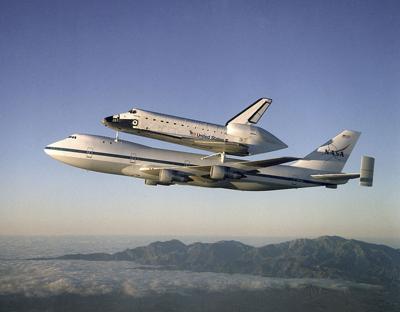Space Shuttle
by larrykeast
(mississauga)
Good morning, just a little note,. Your weather station keeps saying the Space Shuttle will be trucked back from California, if it is forced to land there. Edward Airforce Base. It will be piggy-backed on the top of a 747 Jet, as per NASA. Larry (nasa.com)
Barry's Response - Yeah, that makes sense. That's how I'd transport such a big object. Meteorology will play a big role in an intensive operation like this. What is meteorology? Check it out here. Thanks, Larry.
Weather probably caused the shuttle to land in California instead of its usual home. It has to go back to Cape Canaveral, Florida if it wants to launch again. It's on the back of a jet. There are two 747s waiting at Edwards Air Force Base, about 60 miles northeast of Los Angeles.
The piggy-back flights take a week to prepare, include fuel stops along the way, and use an additional plane to check for ideal (or not) flight conditions. Nearly a quarter of a million dollars.
Once they took it to Paris. It must have been a long hop. One of the stops was in Canada (Goose Bay, Labrador), then Iceland and onward.
It seems like quite the ordeal for show and tell. 2011 was the last year of the shuttle program.
Search this site for more information now.
Now that NASA no longer has any space shuttles in active service.
...and the Space Shuttle Atlantis (STS-135) was the last mission of the Space Shuttle program in 2011:
NASA has been using commercial spacecraft developed by private companies like SpaceX and Boeing to transport astronauts to and from the International Space Station (ISS) since the shuttles retired. As part of NASA's Commercial Crew Program, these companies developed Crew Dragon (SpaceX) and CST-100 Starliner (Boeing).
The new spacecraft are designed to be more cost-effective and capable of multiple missions, including crewed missions to the ISS. As part of the Artemis program, NASA aims to return humans to the Moon and eventually send astronauts to Mars by partnering with private companies.
With the retirement of the space shuttle program, NASA embraced collaboration with the private sector to expand humanity's reach in space. The future of space exploration and the pursuit of knowledge beyond our planet looks bright with this approach.
There's an idea. Walking on Mars is a huge engineering and scientific challenge. We're living in an exciting era of space exploration, and many space agencies and private companies are working on plans to send humans to Mars.
Artemis is NASA's program to return humans to the Moon by the mid-2020s and use that experience to launch crewed missions to Mars. Elon Musk's SpaceX is also excited about sending humans to Mars, and they have their ambitious Starship spacecraft that they hope will make it easier to send humans.
It's tough, though! A successful mission on Mars will require advanced technology, extensive training, and a deep understanding of the Martian environment.
I'm confident one day, a group of skilled and brave astronauts will set foot on Mars, making history and paving the way for humanity's exploration of space. I'm keeping my eyes on the sky, because the journey to Mars has already begun, and it's an exciting time for space exploration!
Do you have concerns about air pollution in your area??
Perhaps modelling air pollution will provide the answers to your question.
That is what I do on a full-time basis. Find out if it is necessary for your project.
Have your Say...
on the StuffintheAir facebook page
Other topics listed in these guides:
The Stuff-in-the-Air Site Map
And,
Thank you to my research and writing assistants, ChatGPT and WordTune, as well as Wombo and others for the images.
GPT-4, OpenAI's large-scale language generation model (and others provided by Google and Meta), helped generate this text. As soon as draft language is generated, the author reviews, edits, and revises it to their own liking and is responsible for the content.



